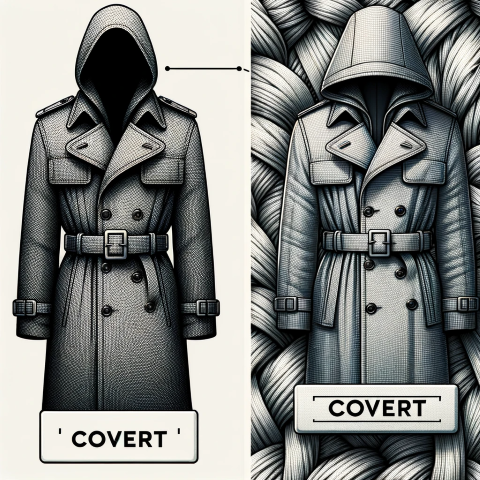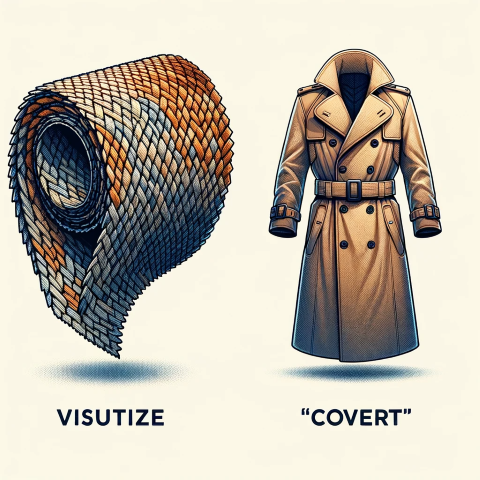Last Updated on: 14-Apr-2024 (3 months, 13 days ago)
Share on Facebook • Share on Twitter
Covert Fabric: Blending Tradition with Modern Fashion
A Brief History of Covert Fabric
Covert fabric, an enduring staple in the textile industry, carries a legacy steeped in tradition and functional elegance. Originating from the pastoral landscapes of England, it was initially woven to meet the robust demands of outdoor activities, especially in equestrian pursuits. Characterized by its tight weave, subtle twill, and understated appearance, Covert has become synonymous with durability and discreet luxury. Over the years, this fabric has transcended its utilitarian roots, weaving its way into the realms of high fashion and everyday apparel. Its unique composition, typically a blend of wool or cotton, gives it a distinctive yet versatile quality, adaptable to various climates and occasions. The resilience of Covert fabric lies not just in its physical attributes but also in its ability to adapt to the changing tides of fashion. From the rugged countryside to the sophisticated avenues of metropolitan style, it maintains its relevance, offering warmth, comfort, and a touch of understated sophistication. The evolution of Covert is a fascinating journey through the fabric's adaptation to new technologies and fashion trends, while still preserving the essence of its rich heritage.
- Woolen Covert
Characteristics: Woolen Covert is primarily made from wool, known for its warmth and natural water-resistant properties. It often features a tight twill weave, enhancing its durability.
Applications: Ideal for cooler climates and winter wear, commonly used in heavy jackets, overcoats, and equestrian clothing.
Advantages: Its natural insulation and durability make it a preferred choice for high-quality, warm outerwear. - Cotton Covert
Characteristics: Cotton Covert is lighter than its woolen counterpart, offering breathability and softness. It typically maintains a tight weave for added strength.
Applications: Suitable for warmer weather and casual wear, often used in lighter jackets, trousers, and everyday apparel.
Advantages: Cotton Covert provides comfort and ease of maintenance, making it a popular choice for everyday use. - Blended Covert
Characteristics: Blended Covert combines fibers like wool and polyester, balancing the benefits of each material.
Applications: This type is versatile, used in a range of clothing from formal to casual wear.
Advantages: The blend often enhances durability, wrinkle resistance, and ease of care, appealing to a broader consumer base. - Water-Resistant Covert
Characteristics: This type undergoes a special treatment to add water-resistant properties, making it more suitable for outdoor use.
Applications: Ideal for raincoats, outdoor jackets, and protective clothing.
Advantages: It offers added protection against the elements while retaining the classic aesthetic of Covert fabric.
Expert Tips for Handling and Maintaining Covert Fabrics
- Regular Cleaning
Importance: Regular cleaning maintains the fabric's appearance and prevents the buildup of dirt and grime.
Method: Gentle washing with appropriate detergents, avoiding harsh chemicals.
Benefit: This approach helps in preserving the color and texture of the fabric over time. - Avoiding Excessive Heat
Importance: Excessive heat can damage Covert fabric, affecting its texture and longevity.
Method: Use low-temperature settings for washing and ironing.
Benefit: Protects the fabric's integrity, preventing shrinkage and texture alteration. - Proper Storage
Importance: Correct storage methods are essential to prevent damage and maintain fabric quality.
Method: Store in a cool, dry place, away from direct sunlight.
Benefit: Prevents fading, mold, and fabric degradation. - Professional Dry Cleaning
Importance: Especially for woolen and blended Covert fabrics, professional cleaning can be crucial for maintaining their quality.
Method: Seek experienced dry cleaners with knowledge of handling Covert fabric.
Benefit: Ensures thorough cleaning without damaging the fabric, ideal for maintaining high-quality garments.
Major Manufacturers and Users of Covert Fabric
- Harris Tweed Hebrides
Known for producing premium woolen fabrics, including high-quality Covert. This Scottish company emphasizes traditional methods combined with modern design. Their Covert fabric is celebrated for its authenticity, durability, and classic appeal. - Ermenegildo Zegna
An Italian luxury fashion house that utilizes Covert fabric in its high-end menswear collections. Zegna is renowned for its craftsmanship and innovation in fabric development, creating sophisticated and durable Covert garments. - Loro Piana
A leader in the luxury goods sector, Loro Piana is notable for its exceptional quality Covert fabrics, often used in their exclusive clothing lines. They focus on the finest materials, with a commitment to excellence in both texture and durability. - Ralph Lauren
An iconic American fashion brand, Ralph Lauren incorporates Covert fabric into its classic designs, merging traditional style with modern sensibilities. Their use of Covert is a testament to the fabric's versatility and enduring popularity in fashion. - Burberry
A British luxury fashion house, Burberry frequently uses Covert fabric in its renowned outerwear collections. Known for blending heritage with innovation, Burberrys use of Covert aligns with its reputation for quality and classic style.
Exploring the Versatile Applications of Covert Fabric
- Outdoor Clothing
Covert fabric's durability and resistance to wear make it ideal for outdoor clothing like jackets, overcoats, and hunting attire. Its ability to withstand harsh conditions while providing comfort and style makes it a top choice for outdoor enthusiasts. - Formal Wear
The fabric's refined appearance is well-suited for formal garments such as suits, blazers, and trousers. Covert brings a unique combination of elegance and durability to formal wear, offering a sophisticated look that lasts. - Casual Apparel
Lightweight and comfortable, Covert is often used in everyday clothing, including casual jackets and pants. Its versatility and ease of maintenance make it a popular choice for casual, everyday wear. - Equestrian Gear
Traditionally used in horse riding attire, Covert provides the necessary durability and flexibility for equestrian gear. Its historical association with equestrian sports underscores its functionality and classic style in this niche. - Designer Fashion
High-end fashion designers utilize Covert for its texture, durability, and timeless elegance in creating unique pieces. The fabric's distinctive look and feel allow designers to craft luxurious, trend-setting apparel.
The Enduring Legacy of Covert Fabric
Covert fabric holds a distinguished place in the textile industry, cherished for its versatility, durability, and timeless appeal. From its traditional use in equestrian gear to its contemporary application in high fashion, covert has demonstrated remarkable adaptability. The evolution of covert, with variations like woolen, cotton, blended, and water-resistant types, caters to a wide range of preferences and climatic conditions. For optimal care, it requires gentle handling and proper maintenance, especially for premium blends. The involvement of leading fashion houses such as Ermenegildo Zegna, Loro Piana, and Burberry highlights its prominence in the industry. Covert's unique combination of practicality and elegance makes it a fabric that transcends seasons and trends, maintaining its relevance in the ever-evolving world of textiles.
In the dynamic landscape of the textile industry, Covert fabric stands out as a testament to the fusion of tradition and innovation. Its journey from the rugged outdoors to the high streets of fashion capitals showcases its versatility and enduring appeal. This fabric's ability to adapt to diverse requirements be it in outdoor wear, formal attire, or casual clothing highlights its unparalleled functionality. The care and maintenance of Covert, while requiring attentiveness, contribute to its longevity, ensuring that it remains a staple in wardrobes and collections worldwide. As the textile industry continues to evolve, embracing new technologies and trends, Covert fabric retains its place as a timeless classic, cherished for its quality, durability, and elegance. Its story is not just about a fabric but about the art of weaving history, culture, and style into a material that transcends time and trends, continually reinventing itself while staying true to its roots.
A medium to heavy twill fabric with a contrast in color between the twill line and the ground. Usually has a mottled or flecked appearance caused by using a warp yarn with 2 or more colors twisted together. The filling generally is of a single color.
Some more terms:
The Ultimate Textile Guide: Types, Care Tips, and Global Industry Giants
A woven or knit cloth. The term is used generically to define many various fabrics. The word is some times used to define an entire industry. For example, "the Apparel Search Company is the leading...
Read about TextileTow Fibers Revealed: The Power of Long, Continuous Strands
Tow is a term used to describe a type of textile fiber that is characterized by its long, continuous strands. Typically, tow fibers are produced from a variety of natural or synthetic materials and...
Read about TowTactel
Tactel is a trademarked brand name for a type of synthetic fiber used in the textile industry. It is a versatile fabric known for its softness, durability, and lightweight properties. Tactel is a...
Read about TactelLock Stitch
This stitch is formed by three or four consecutive stitches of at least a 10 point movement. It should be used at the end of all columns, fills and any element where a trim will follow, such as color...
Read about Lock StitchWarp
A weaving term for yarns in woven fabrics and carpets which run in the machine direction (or lengthwise). Warp yarns are usually delivered to a weaving loom from a beam mounted behind the loom. Woven...
Read about WarpMull
In textile terminology, "mull" refers to a lightweight, sheer fabric that is usually made from cotton or cotton blends. It is known for its soft and delicate nature, making it a popular choice for a...
Read about MullCheesecloth
Plain woven cotton fabric originally used as a wrapping material for pressing cheese. It is loosely woven, thin, light in weight, open in construction, and soft. Carded yarns are always used. It is...
Read about CheeseclothFace Finished Fabrics
Face finished fabrics are textile materials that undergo a surface treatment process to enhance their appearance and texture. The surface treatment or finishing process can be mechanical, chemical,...
Read about Face Finished FabricsOn this page
Add a definition
- The term you want to define
- Its definition in 500 words or less
- Attach an image if necessary.
- Optionally, tell us about yourself in 200 words or less!
Companies for Covert Fabric:
- Company name
- Company address
- Attach a logo, if necessary.
- Optionally, tell us about yourself in 200 words or less!

 The city of U?ak is known for its vibrant textile and recycling industries.
The city of U?ak is known for its vibrant textile and recycling industries.

